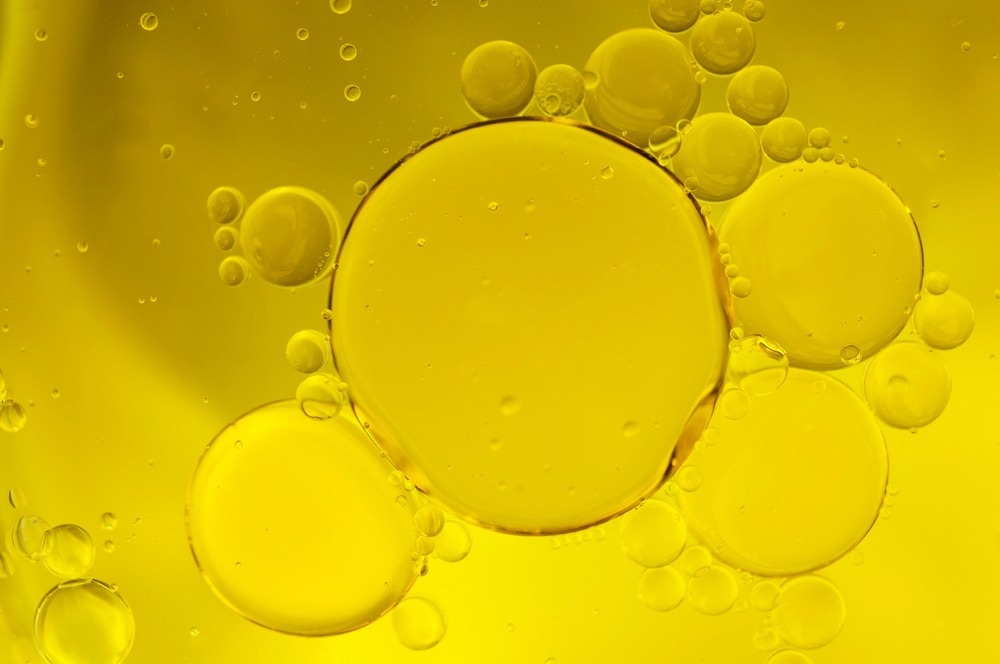Updated by Reginald Davey 13/01/23
An emulsion is a mixture of two liquids that would not normally mix. That is to say, a mixture of two immiscible liquids. By definition, an emulsion contains tiny particles of one liquid suspended in another. Chemically, they are colloids where both phases are liquids. They are typically milky in appearance.

Image Credit: Victor Moussa/Shutterstock.com
A classic example of an emulsion is oil and water when mixed slowly under vigorous stirring. However, when the agitation is stopped, the two liquids separate and the emulsion breaks down. This is an example of an unstable emulsion.
Stable emulsions can be formed from two immiscible liquids when an emulsifier is used. Such emulsions do not separate out after a change in conditions such as temperature or over time.
Types of Emulsion
There are two basic types of emulsions: oil-in-water (O/W) and water-in-oil (W/O) emulsions. More complex emulsion systems can be used, depending on the application they are required for.
Double and multiple emulsions have an emulsion as the dispersed phase in the liquid’s continuous phase. These can be water-in-oil-in-water (W1/O/W2) and oil-in-water-in-oil (O1/W/O2) emulsions. Emulsions can be categorized as macroemulsions, mini emulsions, microemulsions, and nanoemulsions depending on particle size.
Emulsifiers
Emulsifiers contain nonpolar and polar portions which stabilize droplets within an emulsion’s internal phase. They must be nontoxic and stable and compatible with formulation ingredients and, in the case of pharmaceutical applications, the active ingredient.
Emulsifiers include synthetic, anionic, cationic, non-ionic, and naturally-derived substances. Natural emulsifying agents can be sourced from both plant (Xanthan gum, pectin, alginates, and so forth) and animal products including casein, egg yolk, gelatin, and wool fat.
In the food industry, natural emulsifiers are commonly used. These include gellan gum, guar gum, and carrageenan. These types of emulsifiers are preferred due to their non-toxicity, which is a primary food safety concern.
Emulsion Theories
The stability of emulsions can be explained by several theories. These include interfacial film theory, surface tension theory, and oriented-wedge theory, and theories are generally related to the emulsifier’s functional role or the processing conditions for manufacturing emulsions.
Emulsion Applications
Emulsions are used in a variety of industrial and commercial applications. One of the most commonly-used of emulsions is to produce paint. Additionally, they are widely employed in the food and pharmaceutical industries.
The dairy industry, for example, utilizes complex emulsion systems which are stabilized by natural surfactants. Emulsions are used in several food products. In the pharmaceutical industry, they are commonly employed as carriers for lipophilic and hydrophilic drugs.
Emulsions can be used to improve the palatability of drugs with objectionable textures and taste, with drugs such as valproic acid typically formulated as oil-in-water emulsions. Additionally, emulsions are commonly formulated for laxatives, vegetable oils, and oil-soluble vitamins.
Emulsions are also used in topical ointments and creams and for clinical applications such as blood replacement therapy and parenteral emulsions.
Pharmaceutical Emulsion Manufacturing Processes
Several methods can be used to manufacture emulsions for the pharmaceutical industry. The optimal method depends on available equipment and the emulsion component’s nature. At a pharmacy or laboratory scale, a mortar and pestle, homogenizers, and blenders can be employed.
Small-scale methods include in situ soap methods, mechanical methods, wet gum methods, and dry gum methods. The mechanical method is utilized in the large-scale manufacture of ophthalmic and injectable emulsions. This is conducted in aseptic conditions.
Precise control must be utilized in emulsion manufacture to produce emulsions with uniform surface coverage and small, monodispersed droplet sizes.
Stability Issues
Emulsions must remain stable under typical storage and packaging conditions throughout their shelf life. They must retain their chemical, physical, and microbially stability.
Physical stability means that they must remain their appearance, odor, opacity, viscosity, and taste. Flocculation, creaming, coalescence, and breaking can all negatively impact the physical stability of emulsions.
Chemical stability in an emulsion in terms of minimum drug potency and maximum impurity levels must be tightly controlled. Reaction kinetics and functional group reactivity in emulsions are factors that govern the emulsion’s long-term chemical stability. Separation of reactive species in the aqueous and oily phases can improve the stability of an emulsion by reducing its reactivity.
Microbial growth can affect both the safety of an emulsion and cause physical phase separation. Avoiding microbial growth is essential to ensure regulatory compliance, and preservatives are commonly used. Parabens are common preservatives in pharmaceutical emulsions.
In Summary
This article has addressed the question: what is an emulsion? Emulsions are used in the food and pharmaceutical industry to prepare several key products. Several methods can be used to manufacture emulsions. The stability of emulsions is a critical concern to ensure their optimal performance and safety over their shelf life under normal packaging and storage conditions.
More from AZoM: Investigating the Rheology of Emulsion Explosives